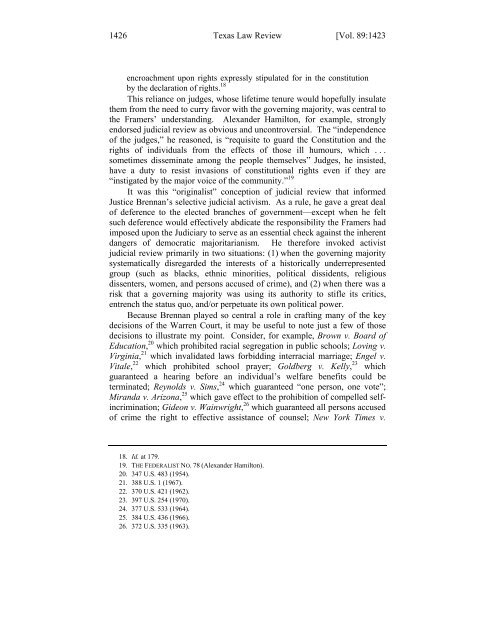Judicial ReEngineering
Judicial ReEngineering
Judicial ReEngineering
Create successful ePaper yourself
Turn your PDF publications into a flip-book with our unique Google optimized e-Paper software.
1426 Texas Law Review [Vol. 89:1423<br />
encroachment upon rights expressly stipulated for in the constitution<br />
by the declaration of rights. 18<br />
This reliance on judges, whose lifetime tenure would hopefully insulate<br />
them from the need to curry favor with the governing majority, was central to<br />
the Framers’ understanding. Alexander Hamilton, for example, strongly<br />
endorsed judicial review as obvious and uncontroversial. The “independence<br />
of the judges,” he reasoned, is “requisite to guard the Constitution and the<br />
rights of individuals from the effects of those ill humours, which . . .<br />
sometimes disseminate among the people themselves” Judges, he insisted,<br />
have a duty to resist invasions of constitutional rights even if they are<br />
“instigated by the major voice of the community.” 19<br />
It was this “originalist” conception of judicial review that informed<br />
Justice Brennan’s selective judicial activism. As a rule, he gave a great deal<br />
of deference to the elected branches of government—except when he felt<br />
such deference would effectively abdicate the responsibility the Framers had<br />
imposed upon the Judiciary to serve as an essential check against the inherent<br />
dangers of democratic majoritarianism. He therefore invoked activist<br />
judicial review primarily in two situations: (1) when the governing majority<br />
systematically disregarded the interests of a historically underrepresented<br />
group (such as blacks, ethnic minorities, political dissidents, religious<br />
dissenters, women, and persons accused of crime), and (2) when there was a<br />
risk that a governing majority was using its authority to stifle its critics,<br />
entrench the status quo, and/or perpetuate its own political power.<br />
Because Brennan played so central a role in crafting many of the key<br />
decisions of the Warren Court, it may be useful to note just a few of those<br />
decisions to illustrate my point. Consider, for example, Brown v. Board of<br />
Education, 20 which prohibited racial segregation in public schools; Loving v.<br />
Virginia, 21 which invalidated laws forbidding interracial marriage; Engel v.<br />
Vitale, 22 which prohibited school prayer; Goldberg v. Kelly, 23 which<br />
guaranteed a hearing before an individual’s welfare benefits could be<br />
terminated; Reynolds v. Sims, 24 which guaranteed “one person, one vote”;<br />
Miranda v. Arizona, 25 which gave effect to the prohibition of compelled selfincrimination;<br />
Gideon v. Wainwright, 26 which guaranteed all persons accused<br />
of crime the right to effective assistance of counsel; New York Times v.<br />
18. Id. at 179.<br />
19. THE FEDERALIST NO. 78 (Alexander Hamilton).<br />
20. 347 U.S. 483 (1954).<br />
21. 388 U.S. 1 (1967).<br />
22. 370 U.S. 421 (1962).<br />
23. 397 U.S. 254 (1970).<br />
24. 377 U.S. 533 (1964).<br />
25. 384 U.S. 436 (1966).<br />
26. 372 U.S. 335 (1963).

















